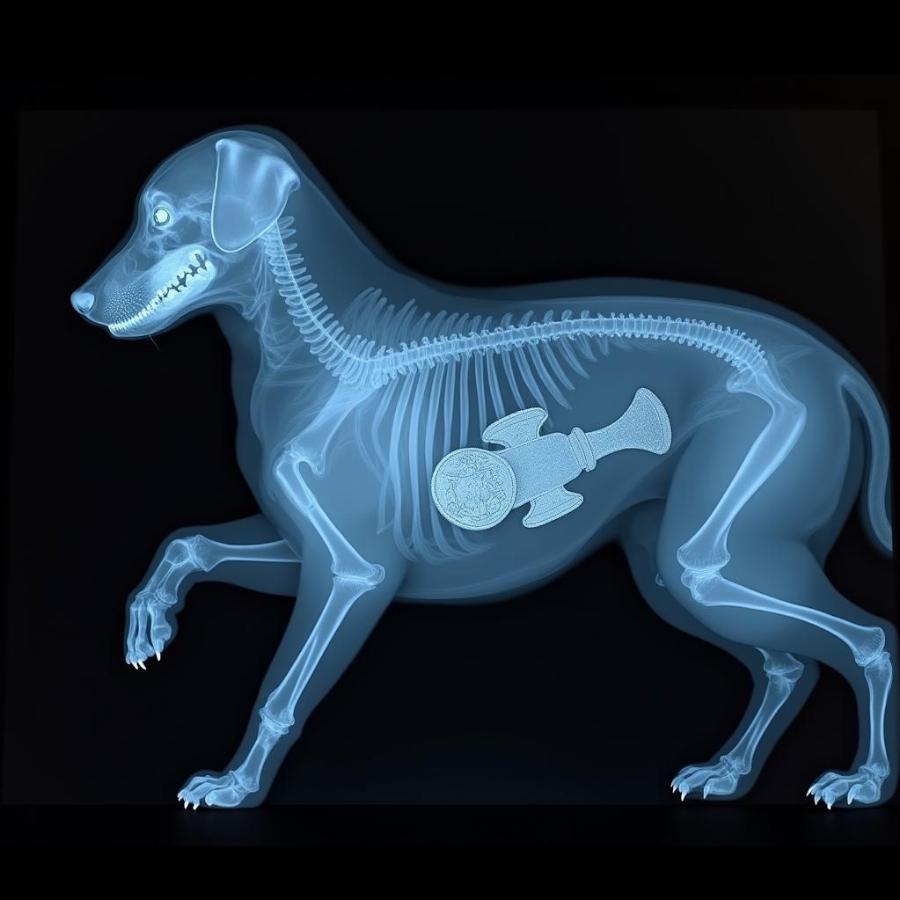When you search for “dog in him xray,” you’re likely concerned about your furry friend’s health and seeking information about canine radiography. This comprehensive guide will explore the reasons behind x-rays in dogs, the process itself, and what you can expect.
What Does “Dog in Him Xray” Mean?
The phrase “dog in him xray” suggests someone is looking for information about x-rays performed on male dogs. While the sex of the dog doesn’t drastically alter the x-ray procedure, certain conditions might be more prevalent in male dogs, influencing the need for an x-ray. This guide covers the general principles of canine radiography, applicable to both male and female dogs.
Why Would a Dog Need an X-ray?
Veterinarians use x-rays, also known as radiographs, to visualize the internal structures of a dog’s body. This diagnostic tool is invaluable for diagnosing a wide range of conditions, from broken bones and swallowed foreign objects to heart and lung issues. X-rays can help detect tumors, bladder stones, and dental problems, providing crucial information for developing an effective treatment plan.
Common Reasons for Canine X-rays:
- Trauma: Suspected fractures, dislocations, or internal injuries.
- Ingestion of foreign objects: Determining the location and type of object swallowed.
- Respiratory issues: Evaluating the lungs and airways for signs of pneumonia, bronchitis, or other respiratory diseases.
- Heart problems: Assessing heart size and shape to detect abnormalities.
- Abdominal pain: Identifying potential causes such as blockages, tumors, or organ enlargement.
- Dental disease: Visualizing tooth roots and jawbone structure.
- Pre-surgical evaluation: Assessing overall health and identifying potential complications.
What Happens During a Dog X-ray?
The x-ray procedure is generally quick and painless for dogs. The dog is typically positioned on a special table, and sometimes mild sedation or restraint is necessary to ensure clear images. A protective lead apron is often placed over areas not being imaged to minimize radiation exposure. The veterinarian or veterinary technician then uses an x-ray machine to take the necessary images.
Understanding the Results
After the x-ray, the images are developed and analyzed by the veterinarian. They will look for any abnormalities in the bones, organs, and soft tissues. The veterinarian will then discuss the findings with you and explain the diagnosis and treatment plan.
What are the Risks of Dog X-rays?
While x-rays involve radiation exposure, the dose used in veterinary medicine is generally considered safe. The benefits of obtaining a diagnosis far outweigh the minimal risks. Pregnant dogs may require special precautions, and your veterinarian will discuss these with you if applicable.
How Much Does a Dog X-ray Cost?
The cost of dog x-rays can vary depending on several factors, including the geographic location, the complexity of the x-ray, and the veterinary clinic. It’s always best to contact your veterinarian directly to obtain an accurate estimate. For more information regarding veterinary costs, check out our article on price of ct scan for dogs.
What if My Dog Swallowed Something?
If your dog has swallowed a foreign object, an x-ray is crucial to determine its location, size, and composition. This information guides the veterinarian in deciding the best course of action, which could range from monitoring to endoscopic removal or surgery.
 X-ray of a Dog That Swallowed a Foreign Object
X-ray of a Dog That Swallowed a Foreign Object
Conclusion
Understanding the purpose and process of canine radiography can alleviate anxiety and empower you to make informed decisions about your dog’s health. If you suspect your dog needs an x-ray, consult your veterinarian promptly. Early diagnosis and treatment can significantly improve your dog’s prognosis.
FAQs
- Are dog x-rays painful? No, the procedure itself is not painful.
- How long does a dog x-ray take? The procedure is usually completed within minutes.
- Can I be present during my dog’s x-ray? This varies by clinic; ask your veterinarian.
- When will I get the x-ray results? Your veterinarian will typically discuss the findings with you shortly after the x-ray.
- What if my dog won’t stay still for the x-ray? Sedation or restraint may be necessary.
- Are there alternatives to x-rays for dogs? Other imaging modalities, such as ultrasound or MRI, might be used depending on the situation.
- How often should my dog get x-rays? X-rays are performed on an as-needed basis, based on your dog’s health and specific concerns.
Beaut Dogs is your trusted source for all things related to canine care, offering expert advice and valuable insights into the world of dog ownership. For any assistance, please contact us via Email at [email protected] for detailed and accurate information. Beaut Dogs is dedicated to providing comprehensive information to help you care for your beloved canine companion. Visit us at https://beautdogs.com.